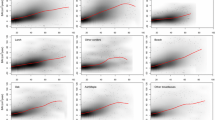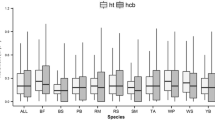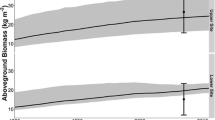Abstract
There is widespread interest in estimating and forecasting individual tree and forest growth rates for restoration and carbon sequestration objectives. Outside intensively managed forests, past attempts have been limited by the lack of accurate long-term monitoring in multi-age mixed native forests to provide estimates of both expected mean diameter increments and the statistical variation in those estimates. A dataset from Eucalyptus-dominated native forests in subtropical Queensland, Australia offers an opportunity to provide accurate estimates of tree and forest growth rates. Over 86,400 trees from 155 native species were identified and remeasured between 1936 and 2011 in 641 permanent sample plots across a 500–2000 mm mean annual rainfall gradient. Individual tree diameter at breast height (DBH) increments observed for all species ranged mainly from 0.01 to 0.5 cm yr−1 (94 % of values), with consistent differences between rainfall zones (mean of 500–2000 mm yr−1), and varying differences between species (155) and stem diameter class (10–100 cm). For some species, diameter increment increased progressively with rainfall (e.g. Eucalyptus siderophloia, Eucalyptus propinqua, and Lophostemon confertus), but in others (e.g. Corymbia citriodora subsp. variegata, Corymbia intermedia, and Eucalyptus biturbinata) the greatest diameter increments were recorded between 1200 and 1600 mm yr−1. Where there were sufficient data, most species exhibited a quadratic relationship between DBH increment and DBH class, but two species (Callitris glaucophylla and Eucalyptus crebra) native to the 500–800 mm annual rainfall zone showed linear increases in DBH increment with increasing DBH. Continued monitoring of these plots would add to their already great value.





Similar content being viewed by others
References
Applegate GB (1982) Biomass of blackbutt (Eucalyptus pilularis Sm.) forests on Fraser Island. Masters Thesis, University of New England, Armidale
Atyeo C, Thackway R (2009) Mapping and monitoring revegetation activities in Australia: towards national core attributes. Aust J Environ Manag 16:140–148
Beetson T (1992) Enhancing the native forest detailed yield plot system. Queensland Forest Service, Brisbane, p 200
Bekessy SA, Wintle BA (2008) Using carbon investment to grow the biodiversity bank. Conserv Biol 22:510–513
BOM (2012) Annual average rainfall in Queensland based on a standard 30 year climatology record (1961–1990). Australian Bureau of Meteorology, Canberra
Booth TH, Williams KJ (2012) Developing biodiverse plantings suitable for changing climate conditions 1: underpinning scientific methods. Ecol Manag Restor 13:267–273
Booth TH, Williams KJ, Belbin L (2012) Developing biodiverse plantings suitable for changing climate conditions 2: using the atlas of living Australia. Ecol Manag Restor 13:274–281
Botkin DB (1993) Forest dynamics: an ecological model. Oxford University Press Inc., New York, p 309
Bowman DMJS, Brienen RJW, Gloor E, Phillips OL, Prior LD (2013) Detecting trends in tree growth: not so simple. Trends Plant Sci 18:11–17
Bowman DMJS, Williamson GJ, Keenan RJ, Prior LD (2014) A warmer world will reduce tree growth in evergreen broadleaf forests: evidence from Australian temperate and subtropical eucalypt forests. Glob Ecol Biogeogr 23:925–934
Brandeis TJ (2009) Diameter growth of subtropical trees in Puerto Rico. Forest Service, Southern Research Station, Asheville, p 39
Cant M, Mannes D (1995) Native forest permanent plot establishment. Brisbane, Department of Primary Industries, Brisbane, p 69
Commonwealth of Australia (2012) Environment Protection and Biodiversity Conservation Act 1999: environmental offset policy. Department of Sustainability, Environment, Water, Population and Communities, Canberra, p 32
Dale G, Dieters M (2007) Economic returns from environmental problems: breeding salt- and drought-tolerant eucalypts for salinity abatement and commercial forestry. Ecol Eng 31:175–182
DERM (2012) Broad vegetation groups of Queensland. Brisbane, Australia. Queensland government, Queensland Herbarium. http://www.ehp.qld.gov.au/ecosystems/biodiversity/regional-ecosystems/bvg.html. Accessed 5 May 2012
Ferraz Filho AC, Scolforo JRS, Mola-Yudego B (2014) The coppice-with-standards silvicultural system as applied to Eucalyptus plantations: a review. J For Res 25:237–248
Florence RG (1996) Ecology and silviculture of eucalypts forests. CSIRO, Collingwood, p 413
GFI Forestry Consulting (2009) Global Eucalyptus map. A cartographic information resource depicting Eucalyptus cultivated forests worldwide. GIT Forestry Consulting SL, Lugo
IPCC (2006) International panel on climate change guidelines for national greenhouse gas inventories. IGES, Hayama
Korning J, Balslev H (1994) Growth rates and mortality patterns of tropical lowland tree species and the relation to forest structure in Amazonian Ecuador. J Trop Ecol 10:151–166
Lewis T, Osborne D, Hogg B, Swift S, Taylor D, Macgregor-Skinner J (2010) Tree growth relationships and silvicultural tools to assist stand management in private native spotted gum dominant forests in Queensland and northern New South Wales, technical report of forest and wood products Australia
Low Carbon Australia and the University of Queensland (2011) Carbon offsets guide Australia. http://carbonoffsetguide.com.au. Accessed July 2013
Montreal Process (2009) Criteria and indicators for the conservation and sustainable management of temperate and boreal forests, p 29. http://www.rinya.maff.go.jp/mpci/2009p_4.pdf. Accessed 6 Nov 2012
Neldner VJ, Wilson BA, Thompson EJ, Dillewaard HA (2012) Methodology for survey and mapping of regional ecosystems and vegetation communities in Queensland. Version 3.2 updated August 2012, Queensland Herbarium, Queensland Department of Science, Information Technology, Innovation and the Arts, Brisbane. http://www.ehp.qld.gov.au/plants/herbarium/publications/pdf/herbarium_mapping_methodology.pdf. Accessed 22 Nov 2013
Ngugi MR, Botkin DB (2011) Validation of a multispecies forest dynamics model using 50-year growth from Eucalyptus forests in eastern Australia. Ecol Model 222:3261–3270
Ngugi MR, Mason EG, Whyte AGD (2000) New growth models for Cupressus lusitanica and Pinus patula in Kenya. J Trop For Sci 12:524–541
Ngugi MR, Hunt MA, Doley D, Ryan P, Dart P (2003) Dry matter production and allocation in Eucalyptus cloeziana and Eucalyptus argophloia seedlings in response to soil water deficits. New For 26:187–200
Ngugi MR, Hunt MA, Doley D, Ryan P, Dart P (2004) Selection of species and provenances for low-rainfall areas: physiological responses of Eucalyptus cloeziana and Eucalyptus argophloia to seasonal conditions in subtropical Queensland. For Ecol Manag 193:141–156
Ngugi MR, Johnson RW, McDonald WJF (2011) Restoration of ecosystems for biodiversity and carbon sequestration: simulating growth dynamics of brigalow vegetation communities in Australia. Ecol Model 222:785–794
Prior LD, Bowman DMJS (2014) Across a macro-ecological gradient forest competition is strongest at the most productive sites. Front Plant Sci 5:1–12
Prior LD, Eamus D, Bowman DMJS (2004) Tree growth rates in north Australian savanna habitats: seasonal patterns and correlation with leaf attributes. Aust J Bot 52:303–314
Queensland Government (1959) Forestry Act. Queensland Government, L Queensland, p 256
R Development Core Team (2011) R: a language and environment for statistical computing. R Foundation for Statistical Computing, Vienna
Silva RP, Santos J, Tribuzy ES, Chambers JQ, Nakamura S, Higuchi N (2002) Diameter increment and growth patterns for individual tree growing in Central Amazon, Brazil. For Ecol Manage 166:295–301
Stephenson NL, Das AJ, Condit R, Russo SE, Baker JP, Beckman NG, Coomes DA, Lines ER, Morris WK, Ruger N, Alvarez E, Blundo C, Bunyavejchewin S, Chuyong G, Davis SJ, Duque A, Ewango CN, Flores O, Franklin JF, Grau HR, Hao Z, Harmon ME, Hubbell SP, Kenfack D, Lin Y, Makana JR, Malizia A, Malizia LR, Pabst RJ, Pongpattananurak N, Su S-H, Sun I-F, Tan S, Thomas D, van Mantgem PJ, Wang X, Wiser SK, Zavala MA (2014) Rate of tree carbon accumulation increases continuously with tree size. Nature 507:90–93
The Ecosystem Marketplace (2011) Carbon catalog. http://www.carboncatalog.org/about/. Accessed 10 Mar 2014
United Nations (2008) The United Nations collaborative programme on reducing emissions from deforestation and forest degradation in developing countries. http://www.un-redd.org/Home/tabid/565/Default.aspx. Accessed 5 May 2014
Weiskittel AR, Hann DW, Kershaw JA Jr, Vanclay JK (2011) Forest growth and yield modelling. Wiley, Chichester
Wu PF, Ma XQ, Tigabu M, Huang Y, Zhou LL, Cai L, Hou XL, Oden PC (2014) Comparative growth matter accumulation and photosynthetic rate of seven species of Eucalypt in response to phosphorus supply. J For Res 25:377–383
Acknowledgments
The data used for this study are stored in a database maintained by the Queensland Herbarium, Department of Science, Information Technology and Innovation (DSITI) and co-jointly held by the Forest Research, Department of Agriculture, Fisheries and Forestry (DAFF). The legacy and contribution of past Queensland Government Forestry Departments and staff in data collection, collation and maintenance for over seven decades is greatly acknowledged. Assistance provided by Jiaorong Li and Rosemary Niehus in GIS, Queensland Parks and Wildlife Service field staff, Jian Wang, David Moore, Rosemary Niehus and Sue Philips for 2011 field measurements is gratefully acknowledged. Peer review and suggestions provided by Dr Don Butler, Dr Arnon Accad and Dr John Neldner for earlier version of this manuscript are acknowledged with thanks.
Author information
Authors and Affiliations
Corresponding author
Additional information
The online version is available at http://www.springerlink.com
Corresponding editor: Hu Yanbo
Rights and permissions
About this article
Cite this article
Ngugi, M.R., Doley, D., Cant, M. et al. Growth rates of Eucalyptus and other Australian native tree species derived from seven decades of growth monitoring. J. For. Res. 26, 811–826 (2015). https://doi.org/10.1007/s11676-015-0095-z
Received:
Accepted:
Published:
Issue Date:
DOI: https://doi.org/10.1007/s11676-015-0095-z




